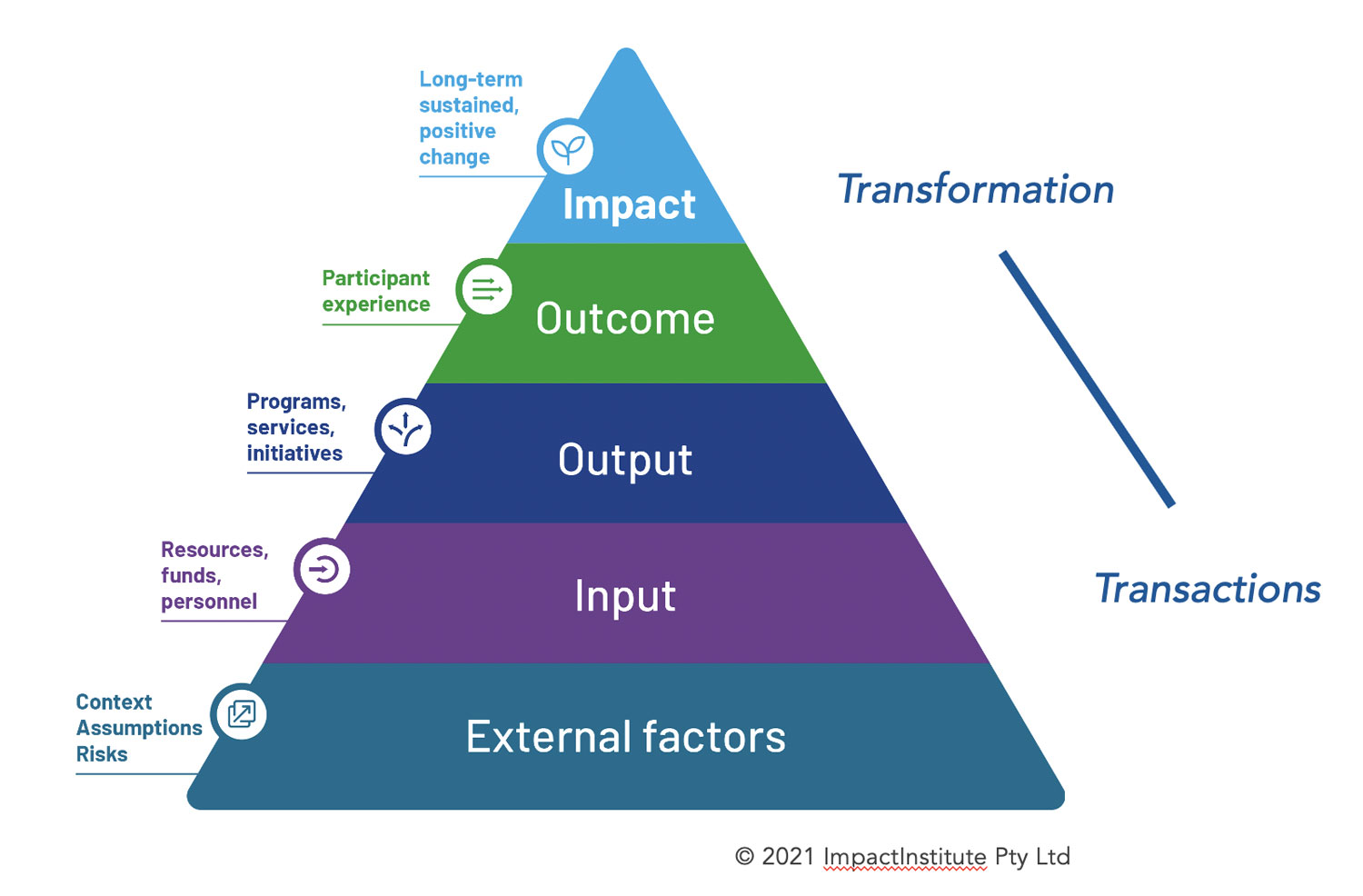What is the difference between purpose & impact-driven organisations? Your organisation has a purpose, but is it making a lasting impact?
It’s a question that preoccupies CEOs and leaders as they navigate a confluence of historical and current factors: COVID-19, social movements, sustainability and the ESG (Environmental, Social and Corporate Governance) movement.
Primarily occupied by the pursuit of growth in an uncertain future, management teams found themselves looking inwards.
Big questions followed: Are we authentically making a difference? Could we be an organisation that’s driven by both purpose and profit (or surplus)? Are we ready to be an impact-driven organisation?
Then came the storytelling questions: Are we telling our story well? Do customers believe in our purpose?
They’re tough questions – made tougher by the fact boards, investors, donors and funders, staff and customers are often confused by what we mean. What is purpose? Isn’t impact the same thing?
Turns out there is a difference between being impact-driven and having a purpose, and it matters for some very important reasons. Let’s look at why.
What is purpose?
An organisation’s purpose is the fundamental reason it exists. To illustrate, here are some great purpose statements:
UNHCR: To safeguard the rights and well-being of refugees.
Camp Quality: To give kids impacted by cancer the chance to be kids again in a safe, fun and supportive environment.
Telstra: To build a connected future so everyone can thrive.
Lego: To inspire and develop the builders of tomorrow.
Chobani: To make better food for more people.
What is impact?
Impact is what happens when an organisation’s purpose is fully realised, experienced by customers, and delivers long-term change. Impact has previously been defined in this way:
Impact is the long-term, sustained change achieved by a program or organisation.
Interestingly, the Impact Management Project definition of impact includes the following caveat:
An impact can be positive or negative, intended or unintended.
These definitions imply a distinction between purpose and impact and point to the opportunity to be intentional about the impact you desire to have in the world.
For example, an organisation’s purpose may be to effect social change. But how effectively is it translating this purpose into reality? Into impact? It could be delivering either good or bad results, or perhaps it’s only helping people in a limited way. People fall back into old habits, or growth isn’t sustained over the long term.
Our definition of impact
With that in mind, we have adopted an optimistic perspective:
Impact is the long-term, sustained, positive change achieved by an organisation reflecting the achievement of its clearly defined purpose.
Digging a bit deeper, it helps to clarify what we mean by positive change. There are three types of positive impact:
A – Acting to avoid harm
B – Benefiting stakeholders
C – Contributing to solutions
It’s a useful acronym because it defines impact as a measurable result. It brings a purpose to life and benefits all stakeholders, including the wider community.
How do you measure impact?
Impact can be quantified and understood by using trusted, evidence-based ways to measure the change experienced by participants and communities as the result of activities undertaken by socially oriented organisations.
Measurement can be based on quantitative and/or qualitative data collected. Surveys, focus groups, observation and interviews provide rich sources of feedback and data on the value of a program or a service. Particularly when data collected can be placed beside baseline or control group data, the ability to do comparative analysis offers insights that will inform program development as well as validate a program model.
Despite the complexity and challenges associated with impact measurement, interest is growing.
For example, an increasing number of organisations are publishing impact reports for shareholders, funders, customers and other stakeholders.
These reports aim to build an organisation’s reputation by proving its meaningful purpose is making a real and measurable difference.
Corporations
- Danone offers a comprehensive overview of its global impact, communicated through its “One Planet. One Health” strategic framework.
- Patagonia’s glossy, magazine-style impact report details its environmental and social initiatives.
- Coca-Cola has published a detailed Business & Environmental, Social and Governance report.
Not-for-profit organisations
- The Salvation Army’s Impact Report 2021 shares stories of transformation and care.
- Australian Wildlife Conservancy has published its first Impact Report to celebrate its 30th Anniversary.
- Bush Heritage Australia published lots of numerical data in its latest Impact Report to demonstrate how it’s making a difference.
Becoming impact-driven – The impact journey
The challenge facing any organisation on the path to being an impact driven organisation journey is to consider if they are limited to only measuring and reporting their (worthwhile) activities.
As we outlined above, long-term, sustained, positive change is a different idea. Impact is best defined, recorded and reported over a longer period of time.
Provided the right strategy, program, service, activities and resources are in place, the transactions represented in inputs and outputs can contribute to the transformation experience over the longer term.
The Impact Journey Framework below, adapted from program logic and theory of change models, illustrates what we mean.

External factors
Every program or service delivered is influenced by external factors. These may include the context in which the products and services are delivered, the assumptions that inform their development and delivery and the risks that need to be managed.
Input
Inputs are best understood as the key ingredients needed to support the programs or services offered by an organisation.
In addition to people, time and money, other inputs can include financial, marketing, technology and innovation or R&D resources.
They’re not ends in themselves, as all stakeholders understand they enable the organisations purpose, as we discussed above.
Output
Outputs are the programs, services, initiatives, products, and myriad other activities resourced by Inputs.
Output measurement is a core activity for any organisation: How many products did we sell? How many programs did we deliver? To how many participants?
In many cases, KPIs are set against the delivery of key outputs to measure the productivity and activity of teams, employees, partners or industry channel partners.
Outcome
Outcomes are our next step on the journey. This is where we seek to understand the lived experience of different stakeholders, such as program participants, customers, and community stakeholders.
For any organisation, the primary function of the outcome measurement stage is understanding the short-medium term experiences for these people.
In the social sector, outcome measurement could include understanding the emotional, psychological or physical benefits experienced by engaging in program or community activity.
For corporates, measurement activities often focus on customer satisfaction – that is, how satisfied was a customer or program participant with their experience of the organisation?
Critically, outcome measurement moves beyond satisfaction with the delivery of the service and has a focus on the outcome of the service or activity as experienced by a participant or customer. What actual difference has it made for that participant?
Outcome data reflects the short-to-medium term experience for a customer or participant. Particularly their experience while in the program or service.
Impact is often understood as what occurs when these outcomes are sustained well beyond the program or service.
In many cases, these sustained outcomes facilitate or enable other meaningful changes or impact that can be experienced by program participants or customers, or within the wider community.
Impact
An organisation’s impact is the long-term, sustained, positive change experienced by individuals who experience programs, services or products delivered by an organisation.
The cascading effect of these outcomes on other people, communities, or the environment connected to these programs, services or products can also lead to additional impact.
Achieving impact requires a long-term view, and to borrow from Simon Sinek and James Carse, is understood by leaders who understand the infinite game. They use quarterly performance goals to ensure they have the ingredients in play that serve the long-term game, or vision.
They understand the goal of this “game” isn’t to win but to stay in the game – to build an organisation that is purpose-driven, strong, healthy and sustainable for many years to come.
Applying that thinking to this model, organisations ensure they measure inputs, outputs and outcomes over the longer term. They gather and use evidence to refine strategy, adjust program or service offerings and better understand customer perspectives.
Measuring impact should be fundamental to doing business, delivering services, engaging customers. A new normal.
For example, a disability service provider that measures outcomes and impact – and uses this data to continuously develop and improve its programs and services – is more likely to observe true impact in the lives of its clients.
An additional dimension here is the power of impact-driven storytelling. When organisations share these amazing impact stories – supported by evidence – it motivates staff, clients, and their families. It builds confidence and inspires participation.
Stories that showcase evidence of impact are also very encouraging for donors and funders who can see how their support has improved quality of life and wellbeing of program participants.
In the corporate sector, impact-driven storytelling is equally relevant. For example, a multinational organisation’s sustained commitment to a carbon-neutral supply chain may result in replanted forests, clean rivers and healthy communities – inspiring it to tell positive stories of true impact, and a purpose statement being experienced by customers and the community.
An understanding of impact and its measurement enables leaders to make that meaningful connection between purpose and true impact – and offer their clients, customers and other stakeholders an authentic and credible basis for their invitation to believe and trust.
What’s next?
Here are a few things to consider as you embark on the impact journey to becoming and impact-driven organisation.
- Begin with the end in mind. What’s your impact vision?
- What’s your organisation’s purpose? Is it clearly defined and experienced by stakeholders?
- Ask your leadership team: Are we committed to creating real impact? Are we ready to be impact-driven?
Ready to increase your impact?
At ImpactInstitute, we partner with clients to support, resource and enable their impact journey. Contact us if you’d like to discuss how your organisation can become impact-driven.
Written by: Mark Jones and David Jack.
For more information visit: Impact Advisory
